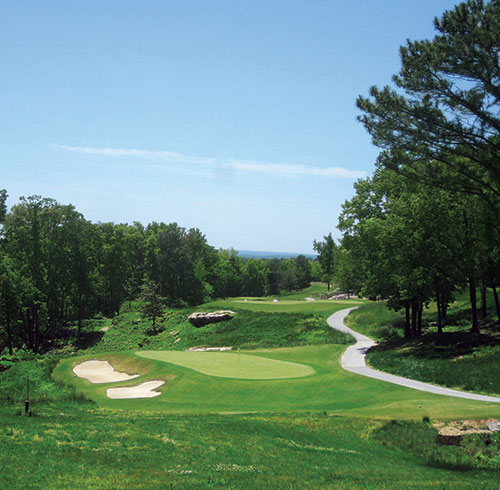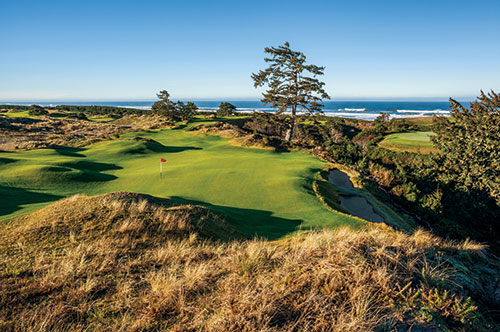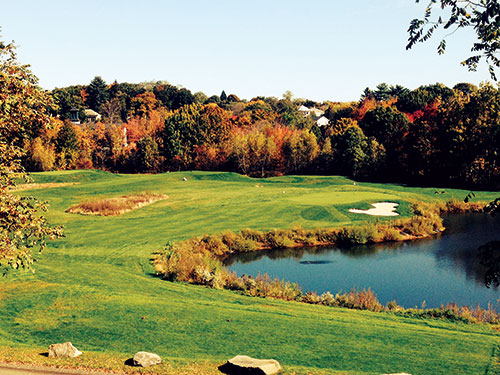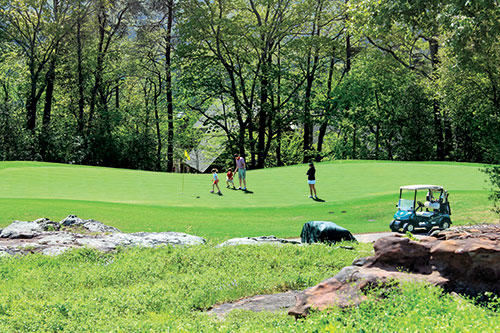Short and Sweet: The perks of par-3 courses
From coast to coast and for golfers rich and poor, par-3 courses are short on yardage but long on value.
Whether it’s the attention of the par-3 contest at Augusta National during the Masters Tournament or special events at a local unsung course, par-3 courses are a valuable part of the industry. They help introduce the game to children, allow avid golfers to practice their short game or squeeze in a few holes, and raise money for environmental causes.
We found three courses that exemplify the versatility of the short courses’ popularity, each special and important in its own way. Button Hole in Rhode Island, Bandon Preserve in Oregon and Vestavia Country Club in Alabama are three courses that prove that size doesn’t matter.
Off the street and onto the green
Button Hole, located in Providence, R.I., is a non-profit initiative with a noble cause: to enrich the lives of youths by providing facilities and programs that develop strong character, teach values and champion success through golf. Young people learn lessons about honesty, humility and perseverance while gaining respect for the environment and their neighborhood.
Prior to becoming a par-3 course, the 26-acre site was a crime-ridden eyesore in the middle of two housing projects, a sand pit rutted by dirt bikes and littered with junk cars. In 1997, David Fay, former executive director of the United States Golf Association, suggested building a short course for kids in Rhode Island.
The Rhode Island Golf Association donated $5,000 for the initial feasibility study, the state gave a preliminary 99-year lease for $1 a year, the USGA committed $220,000 to the project and the USGA Foundation and builder Jack Marshall donated funds to the project.
Opened in 2001, Button Hole has now touched the lives of more than 15,000 kids. The course sees 9,000 rounds a year. The facility is open to the public, but closes in the afternoons for after-school programs.
Button Hole Superintendent John Rourke says the facility focuses on inner city kids.
“We teach them something constructive,” Rourke says. “We’re also increasing the number of golfers by teaching those who would never have gotten into it.”
Rourke, 36, in his third year at Button Hole, came from the private Agawam Hunt Club in Rumford, R.I. But he likes Button Hole’s concept.
“The nonprofit status took me away from the exclusivity of golf,” he says. “It’s taken me away from working with just one group of people. This job is more fulfilling than just helping rich guys improve their handicap. This pay scale is much different compared to where I was, however, there’s more structure here and a different kind of conditioning. I can also bring my son to work, and I’m more accessible. This isn’t a 24-hour-a-day job.”
Before Rourke’s time at Agawam he worked for a regional management company, building and maintaining a lot of golf courses.
“I got divorced and became ill because I was a workaholic,” he says. “I learned the hard way.”
Rourke has no staff during the winter. In season, he has a crew of five that helps maintain the 26-acre facility, which includes a driving range. Rourke has been involved with restructuring maintenance practices and creating a feasible budget for the property.
“Last year, not much was done agronomically; maybe one fertilizer application and one insecticide application,” he says. “But this year, we have a new board. We’re in transition. We have a lot of repair work going on, and we’re getting back to normal.”
Rourke follows a more sustainable maintenance program, maintains higher heights of cut and hand-waters more, which gives him more control. He uses as many native plants as he can and returns nutrients to soil via grass clippings. He also uses volunteer labor, and works with chemical companies that give money to the facility or donate product.
“We do that with everything,” he says, adding that he relies on the Rhode Island Golf Course Superintendents Association to help get donations and used equipment.
Even though Button Hole’s conditions aren’t maintained at the same level as Awagam’s, they’re consistent.
“We want to make sure quality and conditioning is at the beginner level,” Rourke says, adding that a consulting firm helps determine conditions. “Conditions aren’t too difficult, but they’re not neglected either. We cater to the kids so they can have a good round.”
Giving back to Mother Nature
On the West Coast, there’s Bandon Preserve, a 13-hole par-3 course that’s part of Bandon Dunes Golf Resort in Bandon, Ore. Opening in 2012 and designed by Bill Coore and Ben Crenshaw, Bandon Preserve begins atop a sand dune and rolls down toward the beach. The Pacific Ocean provides the backdrop to every hole. It’s a true links course.
“It’s phenomenal par-3 ground,” says Ken Nice, director of agronomy at Bandon Dunes. “When we built the course we weren’t married to 13 holes. We just said, ‘Let’s build the most par-3 holes we can.’
“We’re committed to true links golf,” he adds. “All of the courses were seeded to fine fescue, which means fewer inputs. For example, we’re below 2 pounds of nitrogen per 1,000 square feet. We spoon feed, and there’s no runoff.”
The construction method of Bandon Preserve was identical to that of the facility’s Old MacDonald course, which has sandy soils that drain well.
Bandon Preserve is different from the other Bandon Dunes courses in that all net proceeds go directly to the Wild Rivers Coast Alliance (WRCA), an organization that supports conservation, community and the economy on the southern Oregon Coast. WRCA was founded by businessman Mike Keiser, owner of Bandon Dunes Golf Resort. WRCA was formed through discussions about the needs and opportunities for philanthropic investment in the area with representatives from the community, the nonprofit sector, business and local government.
“Mike Keiser has always been philanthropic,” says Jim Seeley, executive director of WRCA. “He wanted to start a philanthropic organization and had been working on that three years before WRCA was hatched.”
Since the Preserve opened, it — along with Keiser’s contributions — has generated $2 million for WRCA. The Preserve’s in-season rate is $100 per round.
WRCA has done a lot of work to promote tourism and improve water quality and the economics of the fishing industry. It was a catalyst in gaining approval for the Wild Rivers Designated Scenic Bikeway, the first and only such bikeway on the Oregon coast.
The Preserve also supports an endangered plant species called the silvery phacelia. The population of silvery phacelia on the three other courses isn’t as concentrated as it is on the Preserve. Construction of the Preserve, rather than reducing the silvery phacelia, actually has facilitated its recovery. “We’ve done everything to enhance the plant so it can thrive,” Nice says. “It’s tripled in numbers since we opened the course.”

Vestavia Hills’ par-3 course shares its original designer with Augusta National’s par 3, George Cobb.
Every course at Bandon has its own staff and a budget based on square footage, and they operate within that. “We treat the Preserve with every bit of scrutiny as the other courses,” Nice says.
The Preserve, which has received high ratings from guests, is different in another way: The resort allows groups of eight to play at one time. “That’s a unique aspect of that course, and people love it,” says Nice, who oversees a staff of about 100.
Groups that arrive in late afternoon and don’t have enough time to play 18 holes can play that afternoon on The Preserve. “It’s a good precursor to what guests will experience at Bandon Dunes,” Nice says. “Or, for those who have played all day, they can squeeze in another 13 at the end of the day.”
Fun for everyone
Nestled atop the mountains of Vestavia Hills and spanning more than 176 acres, Vestavia Country Club in Birmingham, Ala., began as a successful riding club in 1948 and opened to members in 1950. In addition to the 6,811-yard, 18-hole course with six different tee boxes to accommodate all skill levels, the club features a 9-hole par-3 course which sports MiniVerde ultradwarf bermudagrass greens and three sets of tees. George Cobb, designer of the par-3 course at Augusta National, originally designed the course in 1954.
Neglected for years, the course was renovated in 2011.
“Before the course was renovated, it was a ghost town,” says Owen Coulson, superintendent at Vestavia. “Some members practiced on it, but nobody really cared about it. We barely maintained it, but it’s the main thing you see coming into the club.”
The golf course architect firm of Schmidt-Curley redesigned the course and Landscapes Unlimited rebuilt it. The impetus for the $400,000 renovation was that the club was deciding what it wanted to be — a middle-of-the-road club, or the best.
“It chose the best,” Coulson says, adding the club renovated the pool and tennis clubhouse in addition to the par-3 course. “Those three are best in the region.”
Coulson says different kinds of golfers play the par-3 course — young kids, those who don’t have the time to play an 18-hole round, older golfers, those just looking to practice, middle-schoolers… everybody.
“People can come after work and play the par-3 course in as quick as 45 minutes,” says Coulson, who has been at Vestavia for 13 years.
Vestavia has a lot of fun with its par-3 course. It hosts special events such as a progressive dinner. The dinner, which sells out on the first day tickets are available, starts in the late afternoon. On the different holes, 50 couples enjoy appetizers, drinks and dessert and a bonfire at the end of the round.
The course also hosts night golf, outside events, happy hour (a bar or station is set up on every green), music events (bands set up on the tee boxes), campouts for kids and weddings, for which the club is known.
“It’s a unique and fun piece of property,” says Coulson, adding the conditions are the same as the big course. “We treat it like a championship course.
Photos: Wood Sabold, Owen Coulson, John Rourke












